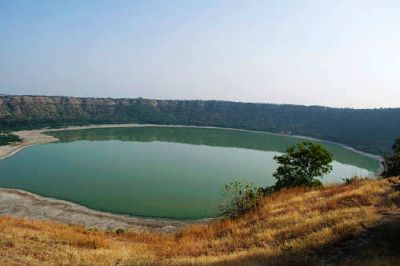A famous lake in India's state of Maharashtra which was supposed to have formed after a meteorite hit the Earth some 50,000 years ago, has changed its color from a green hue to bright pink overnight. Known as Lonar Lake, it is considered a wonder of the nature.
The photos of the lake started to circulate on social media recently. Now experts said that even though the lake had changed color in the past, the transformation had never been so sharp before. They claimed that the changes in the watercolor took place due to either increased salinity in the water or an overgrowth of algae, or a combination of the two.



Analysis of the Lake to Untangle the Mystery
The state officials from the forest department have already collected the water samples from Lonar Lake to determine the exact cause behind the shift. In a recent video posted by state-run Maharashtra Tourism Development Corporation, Indian Geologist Gajanan Kharat explained that the salinity of the lake has increased as the water level has gone down drastically in 2020, making it warmer and thus, resulting in overgrowth of algae.
"This alga turns reddish in warmer temperatures and hence the lake turned pink overnight," said the geologists in the video.
Here is a video by Mr.Gajanan Kharat, Geologist, explaining to us why the colour of #LonarCrater Lake has changed. #LonarLake #MaharashtraTourism #MaharashtraUnlimited #Lonar pic.twitter.com/plZx7YFnF8
— Maharashtra Tourism (@maha_tourism) June 11, 2020
Earlier records indicate that the water body was turning highly alkaline with high salinity, which must have created the perfect environment for bacteria, specifically for halobacteriaceae, to produce a red pigment after gathering sunlight and transforming it into energy. Due to this bacterial outgrowth, the watercolor changes into a reddish hue, explained geologists.
The head of the geography department at Maharashtra's Babasaheb Ambedkar University, Madan Suryavashi, further claimed that as factories and offices were closed for months due to the Coronavirus lockdown, less human activities and restriction in the area could also have accelerated the change in Lonar Lake. "But we will only know the exact causes once our scientific analysis is complete in a few days," he told AFP.
Lonar Lake
The lake is located about 300 miles east of Mumbai, is a notified National Geo-heritage Monument and a popular tourist spot for tourists. It has mainly gained popularity for being the largest basaltic crater.
Lonar Lake includes high levels of phosphorus, which indicates the existence of some common, natural mechanism that accumulates the mineral in these lakes, revealed a study by the University of Washington in 2019.
According to experts, the earliest signs of life on Earth may have evolved in this Indian lake as phosphorus is one of the main six chemical elements of life and also the backbone of DNA and RNA molecules, though a scarce mineral.









